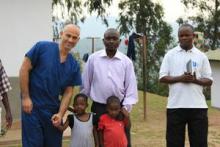A 2008 trip to the Democratic Republic of the Congo opened Dr. Richard Kaul’s eyes to a serious, yet underrecognized health problem in the region: spinal injuries.
A friend who was opening a school in the Congo had invited him to visit in a general humanitarian way, to see whether there was anything he could do to help with her project.
However, "while I was there, I had the opportunity to visit two of the government medical clinics, and I observed that there was a high incidence of young males who had sustained spinal injuries in the mines," he said. The huge mining industry in the Congo is relatively unregulated and hazardous, and spinal fractures are extremely common. The injured young men were brought to the clinic, "but no one had any expertise or knowledge of how to treat them," he said. As a result, many men were sent back to their villages as quadriplegic or paraplegic, and many of them died within a few years from complications of immobility.
In addition, as Dr. Kaul notes on his website, women in this part of the Congo are at risk for spinal problems because they regularly travel several miles on foot over constantly changing terrain with upward of 200 pounds strapped to their upper backs. These packs can contain food, plants, water, or anything else they need to gather while most of the men (and male children as young as 7 years) are working in the mines. This exerts incredible amounts of pressure and force on both the cervical and lumbar spine.
"As you travel throughout the Congo you can see the majority of these women have a very evident slouch and are permanently hunched over," he said.
Dr. Kaul was inspired by this trip to found the Spine Africa Project, a nonprofit organization that has a twofold goal of providing treatment for those with spine injuries and educating the local physicians about spinal surgery.
Dr. Kaul graduated from London University in 1988 and finished medical school at the Royal Free Hospital School of Medicine. He came to the United States for postgraduate medical training at Montefiore Medical Center in New York.
What was your aim in starting the Spine Africa Project?
After my first visit, I started talking to people there about going back and trying to treat patients who were casualties of spinal injuries, and also teaching local doctors to diagnose and manage spinal pathology. A large part of what we are doing is educating the local doctors. It was shocking to me that there was a complete lack of understanding about spinal anatomy and pathology.
There is a small medical school attached to the clinic in which we operate. On our next trip, we will be spending about 25% of our time teaching and giving lectures. We bring the medical students and local doctors in for the surgeries and include them in the preop and postop care of these patients.
The local doctors scrub in on cases and operate with us, so we can demonstrate the technical aspects of surgery to them. We hope to get them to the point where they can handle the simple spinal decompression cases. And to have the project grow and continue, you have to have the local doctors brought on board in a very comprehensive way.
What types of surgeries are you performing?
We aren’t at a point yet there where we can do complex surgeries. All of our surgeries are decompressions or posterolateral or posterior fusions. The interbody fusions and more complicated surgical operations have to wait until we have a reliable source of power. But one of our goals in the future is to be able to accommodate those cases as well.
What are the facilities like in the clinic?
The Panzi Clinic is fairly basic, but there is enough to allow us to carry out surgery. It’s near the border with Rwanda. As in many parts of the Congo, there is sometimes an issue with running water and a reliable source of power. During our last trip, we were in the middle of a case when the power went down, and the anesthesiologist had to manually ventilate the patient. But that’s part of the environment there.
There are small generators there, but in this case, both generators went out, and all we were able to do was apply pressure with gauze until the generator came back on, which took about 15-20 minutes. One of the elements of the project is raising funds to buy more generators for the hospital.

